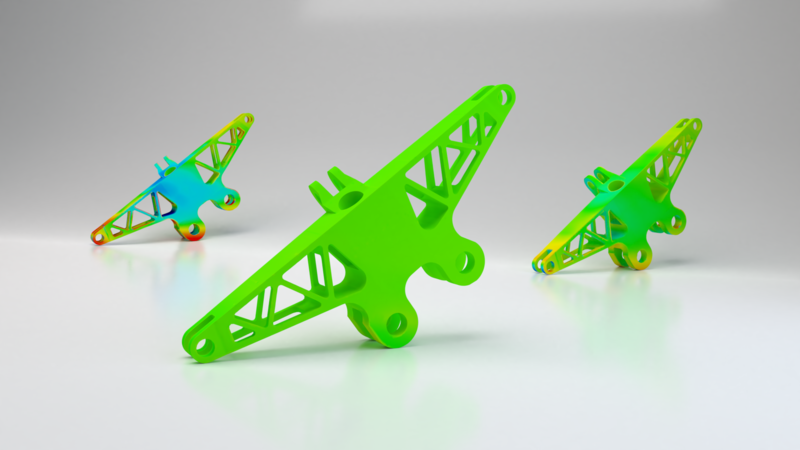Authored By Mr. Santhosh Nagaraju, Technical Specialist, Indo-Pacific – Simufact Engineering, Hexagon and Shripathi V, Senior Manager, Aerospace & Defence, Indo-Pacific Hexagon
With NASA printing space tools on-demand, “3D in Zero G”, and Formula 1 race cars increasingly using 3D printed parts to increase efficiency, the race for Additive Manufacturing (AM) is on!
As the world flags off into the Industrial Revolution 4.0 era, AM, or more commonly recognized as 3D Printing, is now at the driver’s seat for the next journey of technological advancement in manufacturing.
Whereas once this technology was dismissed as mere hype, a 2019 Ernst & Young report found that AM has attracted such exposure that almost two-thirds (65 percent) of businesses they surveyed have now tried applying the technology in business — nearly triple from 2016. Valued at more than US$7 billion as of 2017, the AM industry is expected to reach US$ 35.6 billion by 2023 worldwide, with expenditure on AM crossing US$3.6 billion by 2021 in the Asia-Pacific region. (source)
It is exciting times: AM is rapidly making waves in multiple sectors, in multiple ways, such as Aerospace, Automotive, Energy, and even Medical Engineering.

Shripathi V, Senior Manager, Aerospace & Defence, Indo-Pacific Hexagon
Make in India
For India, AM, as its new ‘driver’, could not come soon enough.
When the government launched its “Make in India” initiative in 2014, it had big ambitions: it aimed to increase the manufacturing sector’s contribution to India’s GDP to 25 percent by 2025, while simultaneously creating 100 million jobs in the country.
However, according to research by McKinsey, India’s manufacturing-sector GDP declined to 7.4 percent between 2013 to 2019, shrunk down from an average of 9.5 percent growth annually between 2006 and 2012.
In 2020, manufacturing generated just 17.4 percent of India’s GDP, not much more than the 15.3 percent in 2000; and in the past 13 years, India’s manufacturing-sector share of employment increased by just one percentage point. (source)
Manufacturing represents one of the greatest opportunities for India, not only to spur economic growth, but also job creation. It is more than just intangible value, however.
McKinsey identified great potential in 11 manufacturing value chains in India — among them chemical products and petrochemicals, agriculture and food processing, electronics and semiconductors, capital goods and machine tools, iron ore and steel, and automotive components and vehicles– which can generate, within the next seven years, about $320 billion more in gross value added (GVA) than they do now.
To be sure: Manufacturing is India’s shining star. So what will it take? And how can AM help India get there?

Productivity and technology
Additive manufacturing, commonly known as 3D printing (3DP), is a digital manufacturing process that involves slicing three-dimensional digital designs into layers and then producing additively, layer by layer, using AM systems and various materials.
This means the possibilities are endless for its use applications; allowing for greater flexibility on design, precise manufacturing, and molding of highly specialized and intricate parts.
As such, more and more companies are getting on board with AM, and in India, it is no different. In December 2020, the Ministry of Electronics and Information Technology (MeitY) launched its National Strategy for Additive Manufacturing– thus recognizing and validating the huge potential for AM to revolutionize the Indian manufacturing sector.
In this, we feel that AM can play a big role in what India needs to reach its US$320 billion potential, in addition to AM being a key component of the Industrial Revolution 4.0.
We see several key trends emerging in the industry, especially in improving automation and streamlining workflows with the help of Computer-aided Engineering (CAE) software. Moreover, AM is being boosted by increasing machine connectivity and the rise of ‘digital twins’ with the help of CAE software. Digital twins are exact and specific digital representations of a specialized part, for example, which would then be replicated in AM.
All this points to a trend in disruptive manufacturing, where AM is very much in use for high-value, low-volume manufacturing parts or components– this is especially true in highly-specialized industries such as Aerospace, Automotive, and Medical industries.
For example, weight optimization is an increasingly key consideration, especially in the Aerospace and Automotive industries. The ability for AM to produce parts and components using different materials to optimize for weight is incredibly useful; take for example in the production of electric vehicles (EVs) where weight plays a huge role in energy consumption. Or in the medical industry, for example– the production of prosthetics and other medical devices requires high levels of specification and customization, something which AM is perfectly poised to deliver.
What India’s AM industry needs
The benefits of AM are manifold– from helping manufacturers in India recover from the pandemic to speed up innovation to market– but India’s manufacturing value chain must increase its productivity to become and stay globally competitive.
Indian manufacturers lag behind their global peers in production planning, supply chain management, quality, and maintenance—areas that contribute to their lower productivity. Research shows that India’s manufacturing sector is almost four and five times less productive, on average than their counterparts in Thailand and China, respectively. (source)
In this, it is undeniable that improvements– even small ones– to key manufacturing processes would increase the productivity of Indian companies, especially those within McKinsey’s 11 ‘chosen’ manufacturing value chains.
Likewise, we believe that integrating Industry 4.0 automation technology, investment in data analytics, shop floor reporting, and the re-and-upskilling of the workforce could accelerate productivity. This means the technological ‘know-how’ in securing the latest in manufacturing solutions and intelligent approaches to problems and inefficiencies.
Already we are seeing how productivity gains can be achieved with advanced technologies in the AM space. For example, Hexagon’s new Generative Design Solution cuts AM design processes by up to 80 percent– the MSC Apex Generative Design produces stress-optimized, 3D printable designs automatically to reduce design cycles from days to hours. (source)
In fact, it aims to improve productivity by up to 80 percent compared to classic topology optimization. The software produces a part design that is ready for additive manufacturing (DfAM) within a few hours – a fraction of time usually required – making reliable additive manufacturing more cost-efficient and accessible.
In MSC Apex Generative Design, the designer only needs to specify the boundary conditions and design objective. Multiple lightweight design candidates that explore the possibilities of the design space will be produced that provide optimal stress distribution and minimize weight.
This enhances the creative process, so designers have more time to optimize the product’s concept and integrate additional features that add value. The software’s intelligent smoothing technology ensures that every candidate has a perfect finish that is ready for print.
In addition, solutions in advanced simulation processes continue to aid the growth of AM. For example, Simufact Additive is a powerful and scalable software solution for the simulation of metal-based additive manufacturing processes, which enables smooth metal 3D printing with high dimensional accuracy and quality. There is also Digimat-AM, which is a solution of Digimat Software that simulates the printing process and helps printer manufacturers and end-users identify manufacturing issues while optimizing printing parameters for productivity and precision. In this way, Hexagon provides an end-to-end solution for OEM, Service Bureau, and Research Institutes with its hardware and software solutions.
Challenges in the Industry
To be sure, there are challenges towards the full adoption of AM in manufacturing, not least being cost. While manufacturers save a lot on material cost due to high accuracy and reduction of waste and error, the actual cost of AM is still relatively higher compared to conventional manufacturing. In addition, AM’s ability for high accuracy and specificity means it is too costly for manufacturing in high volumes. Not only that, it is highly reliant on material quality– the quality of material greatly determines the quality of the parts, while even the availability of materials — namely polymers, ceramics, and metals.
However, additive manufacturing promises innovation and manufacturing productivity advances, and India is poised to take full advantage of its potential benefits.


